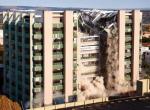Critical flaws in bridge
Guidelines for the construction of a temporary bridge at Grayston Road in Sandton over the M1 are not implemented.
The temporary structure collapsed in October, killing two people and injuring several others.
Testifying at the inquiry into the collapse yesterday, civil engineer Richard Beneke, who studied the scaffolding company Forma-Scaff’s drawings after the accident, said it was clear from the photographs that some “sections were completed only to a small extent, and that they were partially completed in the region around the support on each side of the M1 motorway”.
He said the temporary bridge was still under construction, saying progress “was clearly less than the full extent shown in the drawing”.
“I considered some of the bracing elements to be inadequate to provide the necessary lateral restraint when the super-shores are subjected to concrete loads.
“They were not massively inadequate but I did not consider them sufficiently adequate,” he said.
Asked if he found proof that the stress caused by wind was taken into account in the drawings, Beneke said he did not know to what extent it was taken into account because of the “uncertainties” on the design drawings.
He said he was concerned that the wind loading appeared to be quite high in relation to the strength of the bracing system.
“I cannot say exactly what the designer’s intention was,” the engineer said.
Beneke said the documentation he analysed for his report as an expert witness for construction firm Murray & Roberts did not have a clear prescription for the sequence of the implementation of the components of the bridge.
He said the design’s implementation sequence for the structure was key for safety and ensuring that the bridge was completed within the required time and resources.
“There are many issues to be considered and to be considered jointly both by the construction people and design people,” he said.
Under cross-examination by Johannesburg Development Agency lawyer Willem le Roux, Beneke said he would have been concerned with opening the highway without a risk assessment.
Earlier testimony pointed to missing bolts, a gust of wind and an unsatisfactory design being among the reasons why the bridge collapsed.

















